An inspirational graduation speech from Jack Ma. I especially like the way he describes change: “Change is painful, but not changing is bitter.”
Archive for the ‘doing’ Category
Jack Ma: “Change is Painful, But Not Changing is Bitter”
Posted in doing on August 25, 2014| Leave a Comment »
Visually enforced presentation structure with Prezi
Posted in 3d printing, doing, robotics on October 8, 2013| Leave a Comment »
This past weekend at Code Camp, I saw Yosun Chang‘s presentation on hacking Google Glass. I liked how her slides flow from 10,000 foot view of all the slides and zoomed into each slides. She was using Prezi.
I’ve seen Prezi presentations before but had not the opportunity to use it. I had been using PowerPoint and Keynote.
I have to give a speech at Startup Speakers, and I turned the opportunity into using Prezi. I like how Prezi enforces a structure to the presentation by just a simple graphical layout.
Here’s my 6-minute speech on my excursion on evenings and weekends into 3d printing in the last few years:
Tried Glass
Posted in doing, robotics, software on October 6, 2013| Leave a Comment »
I finally got to tried Glass. I attended Yosun Chang‘s Code Camp session on hacking Glass and she let the audience test some of the hacks she did with Glass. It was rather light and felt comfortable on the head.
I saw up close the structure that holds the OMAP4430 processor, 500+MB memory, 16G storage, GPS, camera, accelerometer, speaker, mic, light sensor and touch sensor. There is a battery that’s designed to hang behind the ear when Glass is worn. The most visible piece is the clear block of plastic with a builtin prism to reflect the lights from the LCD screen to the eye’s upper right field of view.
I think it has huge potential for sensor fusion where the user intent could be surmised from the sense information of the accelerometer, mic, light, touch, and other sensors.
But NOT the use case of deploying the head as a mouse. One of hacks had the wearer browse items projected on a virtual cylinder by moving the head. A person could easily get a neck cram and maybe develop a new form of carpal tunnel. Using gaze of the eye to track cursor position could be interesting, although currently there is no camera point at the eye. Opportunities for future versions of Glass.
In the mean time, I took a picture with me wearing Glass.
Startup Speakers
Posted in doing, tagged doing on July 10, 2013| Leave a Comment »
It’s been over 1 year since I joined the Startup Speakers Toastmaster. I had completed 10 speeches in the first 7 months. Then I become the VP of Education, responsible to schedule duties for all the members. In that role, I used Doodle to poll for availability and used Google spreadsheet to setup the schedule, with automatic generation of the agenda for each meeting. For the various special events, such as Speech Contests and Pitch sessions, I encouraged members to take lead to run the event, which enabled them to work toward their Competent Leadership goals. My duty as VP of Education has since ended and I decided not to pursue officer roles in order to focus my time on MOOC classes and other endeavors.
Why did I join Startup Speakers?
Recently, I found my speaking skills degrading. I recalled how Toastmasters had helped me to become a competent speaker who can manage an audience of several hundred people. Prior to Toastmasters, I would sweat a lot when I had to speak in front of an audience and I was too nervous to come up with meaning words to engage the audience. Over 10 years of Toastmaster had helped me become a much better speaker.
In the mid 2000’s, I was presented to customers every week, so I did not have to attend Toastmaster to maintain my speaking skills. In 2012, I felt it was time to practice public speaking again. I visited a number of clubs and found this dynamic and enthusiastic group that comes together at 7am in the morning to practice speaking and leadership skills. Many of the folks are much younger than I but I fit in well.
Now I continue to work on speeches at this Toastmasters.
Startup Speakers Toastmasters meets every Wednesday morning 7-830a at Plug and Play Tech Center in Sunnvyale. Info is available at the meetup.
Photo with Matz
Posted in doing, software on October 18, 2012| Leave a Comment »
I had the opportunity to attend an event where the creator of Ruby was speaking. Matz was extremely friendly and he was gracious enough to take a picture with me.
Completed AI Online Course
Posted in doing, robotics, software on December 22, 2011| Leave a Comment »
I just received my certificate for the “Introduction to Artificial Intelligence” online course offered by Sebastian Thrun and Peter Norvig. I’m one of 23,000 who received the certificate, for doing well in the homework, midterm, and final exams. The class was one of three open online courses offered as an experiment by Stanford. Enrollment reached 160,000 students from 190 countries. The course started in September and ended in December.
I finally got ot understand how probability and statistics could be applied to make sense of data. Dr. Thrun explained very well the applications of bayesian statistics and especially particle filter. I had years and years of statistical theories in math, physics, finance, computer science classes.
These 3 classes have launched the Massively Open Online Course revolution in education.
Energy Matters
Posted in doing on March 9, 2009| Leave a Comment »
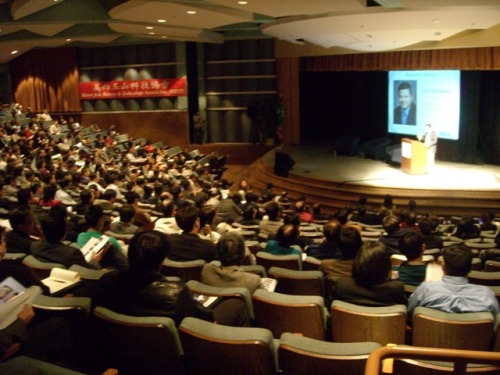 At the Monte Jade annual conference on March 7, Dr. Arun Majumdar of Berkeley gave a very interesting talk on energy use and the opportunities for improvement. He presented lots of data. I found 3 of his points especially interesting:
At the Monte Jade annual conference on March 7, Dr. Arun Majumdar of Berkeley gave a very interesting talk on energy use and the opportunities for improvement. He presented lots of data. I found 3 of his points especially interesting:
1. When looking at overall energy use, 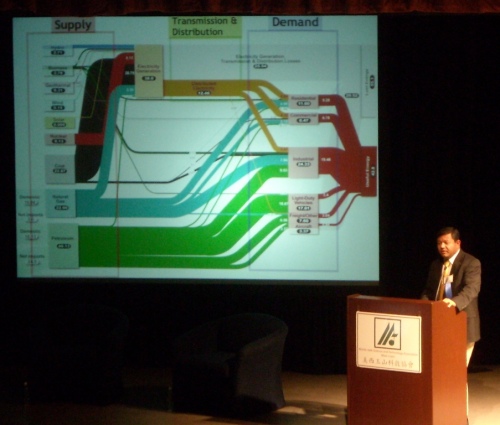 there are 9 sources of supply and 6 areas of demand. Even high growth rate in solar would take years to be of significant impact — that should not stop solar.
there are 9 sources of supply and 6 areas of demand. Even high growth rate in solar would take years to be of significant impact — that should not stop solar.
2. Abatement of energy use is the most efficient and effective way in the short term to solve the energy crisis. There are many ways, including changing the way we build buildings and how a building is put together. These savings 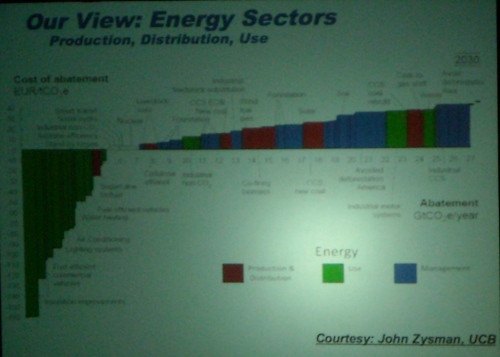 are extremely significant.
are extremely significant.
3. Battery, energy storage, has improved little. Storage capacity has doubled in 60 years. New development in nanotechnolgy could help.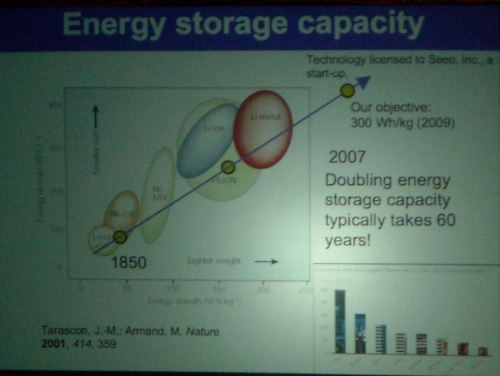
By focusing in these areas with new technologies and software, significant headway could be made in the next 3-5 years to improve the energy problem.
Copyright (c) 2009 by Waiming Mok
A Simple Electric Motor
Posted in doing, tagged electric motor on February 22, 2009| Leave a Comment »
I learned about this motor from the Foothill CNET 119 class I’m taking. The instructions to build this Beakman Electric Motor is by Chris Palmer.
This motor shows the marvel of nature:
- voltage potential brings about an electric field (battery and wire)
- electric field generates magnetic field
- 2 magnetic fields in same direction cause repulsion (magnet and wire)
and the marvel of man’s ingenuity:
converting this knowledge into a device (electric motor) that’s used in so many applications from disk drives to garage door opener to cars.
I certainly have learned from this simple experience, reminding me why I was a physics major a long time ago.
To make the motor work, be sure of the following:
- the wire must be insulated wire, so the coil does not short
- one end of the wire has the insulated wire removed by sanding; the other end has only one side of the insulation removed (this ensures that the wire generated magnetic field is turned on and off as the wire spins, enabling the repulsion of the 2 magnetic fields to continue the spinning of the wire)
- regularly sand the ends of the wires again, as there are occasionaly electric arcs that bring about deposit (carbon?) on the wire that prevents electrical conduction
Copyright (c) 2009 by Waiming Mok
SDForum Through the Years
Posted in doing, software on January 21, 2009| Leave a Comment »
I was at an SDForum party in its offices and I noticed this chart, which shows the various Special Interest Groups (SIG) that were active through the years.
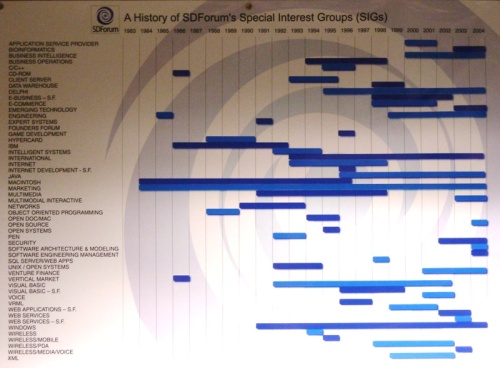
The chart ended on 2004. As of the end of 2008, there are 16 active SIGs, some of which did not appear at the end of 2004. The software landscape is ever changing.
- Business Intelligence
- Cloud Services & SOA
- Emerging Technology
- Engineering Leadership
- International
- Java
- Marketing
- Mobile IP
- Search
- Security
- Semantic Web SIG
- Software Architecture & Modeling
- Start-up
- Venture Finance
- Virtual Worlds
- Web Services SIG
- Windows
Copyright (c) 2009 by Waiming Mok
Key Lessons from Black Swan
Posted in doing, tagged black swan on December 12, 2008| Leave a Comment »
I find NNT‘s Black Swan stimulating. Here’s what I’ve learned:
- The world split into 2 parts:
- the nonscalable and mildly random, history crawls, ruled by bell-curve and Law of large numbers
- the scalable and wildly random, history jumps, ruled by power laws+Pareto–Zipf+Yule+Mandelbrot+fractal
- Beware that books, games don’t necessarily apply to the real world
- Avoid noise, usually generated by news and media
- Don’t be the turkey: future projection using history could be detrimental
- We do not know much about the past, especially causes and effects — “look at a puddle of water, … and try to reconstruct in your mind’s eye the shape of the ice cube it may once have been.”
- We just can’t predict, esp. Black Swans
- Work to be a skeptical empiricist, for the brain tends to operate using intuition, making mistakes relative to reality, and the brain is not built to deal with Black Swans
- Think fractal, Black Swans could turn gray
- Be open minded, don’t be stuck with a particular theory
- Beware and leverage the scalable: winner takes all, Matthew Effect
- 80/20 rule is also the 50/01 rule
- Apply the 90/10 rule: be ultra-conservative 90%, hyper-aggressive 10%
- Winners might have gotten there via luck, Black Swans could change things
- Prepare and be ready for serendipity
- Seize any opportunity — they are very rare
- Don’t run after the train – “Missing a train is only painful if you run after it!”
- Be the one to reign. … It’s difficult to be a loser in a game you set up yourself.
- You always control what you do; make this your end.
Copyright (c) 2008 by Waiming Mok
Black Swan, Part 1
Posted in doing, tagged black swan on December 3, 2008| Leave a Comment »
Just finished reading Part 1, first 133 pp., of NNT‘s Black Swan. Teleb presents  his observations and conjectures on how we humans are not equipped to see and learn from the (1) rare events that have (2) significant impact and we tend to (3) ignore these events. These 3 points define the Black Swans. For me, Teleb jogs me with very interesting set of ideas, while prompting me to question what I do, how I think and interpret the world. As he presents his argument with stories, some real-life, some with names changed,
his observations and conjectures on how we humans are not equipped to see and learn from the (1) rare events that have (2) significant impact and we tend to (3) ignore these events. These 3 points define the Black Swans. For me, Teleb jogs me with very interesting set of ideas, while prompting me to question what I do, how I think and interpret the world. As he presents his argument with stories, some real-life, some with names changed, 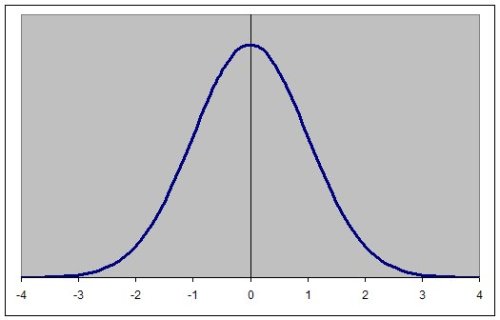 some thought experiments, it’s hard for me to say that he’s scientific in his approach. At the same time, Teleb suggests that traditional scientific approaches in social sciences
some thought experiments, it’s hard for me to say that he’s scientific in his approach. At the same time, Teleb suggests that traditional scientific approaches in social sciences 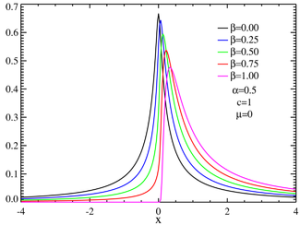 (e.g. economics, or looking at things like Black Swan) have too simplified models (e.g. Bell Curve) that do not reflect reality (more Mandelbrot like). From reading Part 1, I gain new perspectives and a recurring pinging in my mind to question how I think and look at the world. Worth reading.
(e.g. economics, or looking at things like Black Swan) have too simplified models (e.g. Bell Curve) that do not reflect reality (more Mandelbrot like). From reading Part 1, I gain new perspectives and a recurring pinging in my mind to question how I think and look at the world. Worth reading.
There following are some interesting concepts from Part 1:
- Teleb says that Black Swans are invisible to most humans because we are not equipped to think about randomness, and ignore what could have happen, as it is hard to see and think about such abstractions. Experts often use simplified models like the Bell Curve erroneously to describe what we see and then derive decisions from these models. Sometimes, by luck, one among millions, could end up successful over a long period of time, but could still hit the Black Swan because it is not in model. And the Black Swan wipes out all the gains that were gotten from the previous successes.
- Teleb tells a story of casinos spending millions to manage risks with gambling and monitor cheating with sophisticated security equipment, and yet for the Mirage Casino which lost hundreds of millions of dollars because they lost Siegfried and Roy due to an unexpected tiger mawing of Roy.
- World environments are either Mediocristan (non-scalable, winner takes a bit … ) or Extremistan (scalable, winners takes almost all … )
- Humans think in 2 modes: System 1 (“intuition”, effortless, automatic, fast, opaque, …) vs System 2 (“thinking”, effortful, reasoned, slow, logical, …, self-aware)
- “Most of our mistakes in reasoning come from using System 1 when we are … thinking that we are using System 2.”
- The world is more nonlinear than we think. E.g. you play tennis every day with no signs of improvement, then after years of playing, one day, you start beating the pros.
- Don’t be like turkey. A turkey is fed every day for 1,000 day — the turkey would be thinking the 1001th day bring food again, but on that day, the turkey goes on the Thanksgiving table.
- The dead and failures are silent. We tend not to count them, when we look at statistics of those who have succeeded, and then start attribute what led to these people’s success are due to what they did rather than randomness…
- To deal with these biases and innate handicaps, Teleb suggests that we look at reality, avoid interpretation based on our simple models of the world, be always skeptical, and keep an open-mind. For, to think out of the box, especially to catch a Black Swan, you cannot be stuck inside the box, where Black Swans could not be seen.
Copyright (c) 2008 by Waiming Mok
Connected Twitter to Facebook
Posted in doing, tagged Feeds, twitter on October 15, 2008| Leave a Comment »
Using the Twitter application in Facebook, I now have
WordPress blog updates -> (Twitterfeed) -> Twitter <-> Facebook.
Copyright (c) 2008 by Waiming Mok
Severn’s Call to Action, at 12-Years Old
Posted in doing, tagged green, inspiration on October 5, 2008| Leave a Comment »
Inspiring call to action by a then 12-year old Severn Suzuki at the 1992 Earth Forum. While we’re at 16 years later, let’s heed her words:
Connect WordPress to Twitter
Posted in doing, tagged twitter on September 24, 2008| Leave a Comment »
Talking about mashups, there are some good tools to connect WordPress to Twitter:
http://www.quickonlinetips.com/archives/2007/04/10-best-twitter-tools-for-wordpress-blogs/
As I tried these, most of these do not work with the WordPress service — they would work with a WP server you control… TwitterFeed should work using OpenID. I don’t know enough about this to use it yet. Also looking into some form of RSS feed from WordPress to Twitter. I’m now trying TwitterFeed, setup to poll every few hours for changes in WordPress and send any updates to Twitter.
In the setup for TwitterFeed, I use https://waimingmok.wordpress.com/feed for the RSS feed. Let’s see if this works.
Copyright (c) 2008 by Waiming Mok
Fail, To Learn
Posted in doing, tagged fencing on September 19, 2008| Leave a Comment »
Tony suggested to me to enjoy being hit, so I could focus on thinking thru the blade actions. Every time he asked me what happen in an action, I could not say, as my mind was stressed on protecting myself from being hit.
What I needed to learn is to have control of the blade and to feel thru the blade what the opponent is doing in order to develop my moves. That awareness, plus a ready mind to apply the right speed and action would make me a better fencer. So let the opponent hit (fail), and focus on control and awareness, and learn. As I watch the more experienced folks, their actions are more crisp, not out to score a hit or avoid being hit. They spend their time on thinking thru the actions, faints, deceives, parries, ripostes… I see this mode of learning more with foil than sabre.
Copyright (c) 2008 by Waiming Mok
What’s 1% of a day?
Posted in doing, tagged Ways to think on September 13, 2008| Leave a Comment »
As an estimate, it’s less than 15 minutes each day. This can be computed without any calculator as follows:
There are 24 hours each day. ’24’ is near ‘25′ and 25 times 4 equal 100. So as an approximation, 1 hour or 60 minutes consist of 4% of each day. Then, 1/4 of an hour or 15-minute is 1%.
Now, 1/96 (15 minutes) is bigger than 1/100, so 15 minutes is longer than the actual 1% of a day. To check the number, we use a calculator, which says 1% of day consists of 14.4 minutes.
This method of thinking is inspired by Herb Simon, whom I had the opportunity to listen to when I was at Carnegie-Mellon. Dr. Simon’s point was that using our mind and the available information, we can figure things out quickly, without turning on a calculator or a computer. One example he told was on how to quickly figure out the circumference of the earth:
From Los Angeles to New York is approximately 3,000 miles and crossing the continental U.S. spans 3 times zones, so each time zone is approximately 1,000 miles. There are 24 times zones in going around the earth, so an estimate for the circumference of the earth is 1,000 times 24 or 24,000 miles. Googling “earth circumference” comes up with 24,902 miles. So we obtained a good estimate just using our mind and some common knowledge.
Copyright (c) 2008 by Waiming Mok
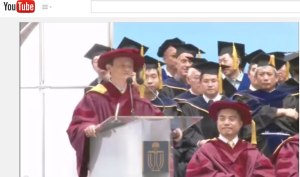
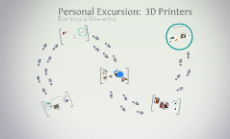

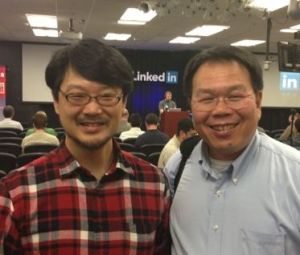
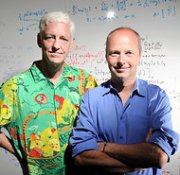
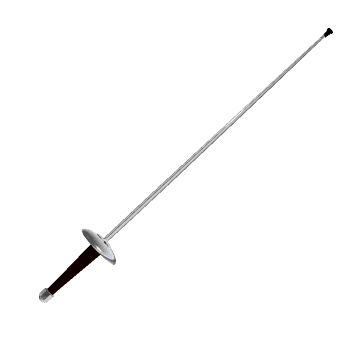
You must be logged in to post a comment.